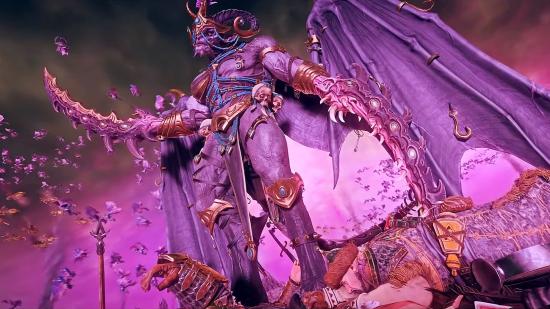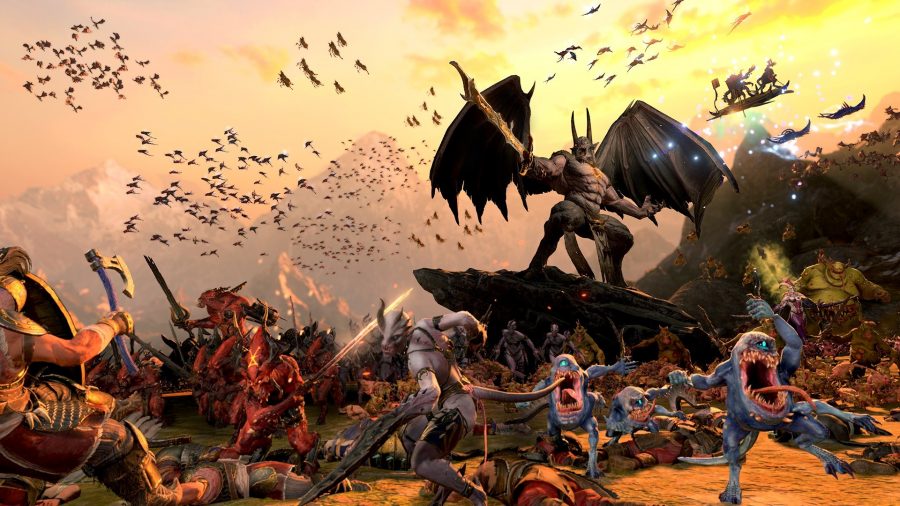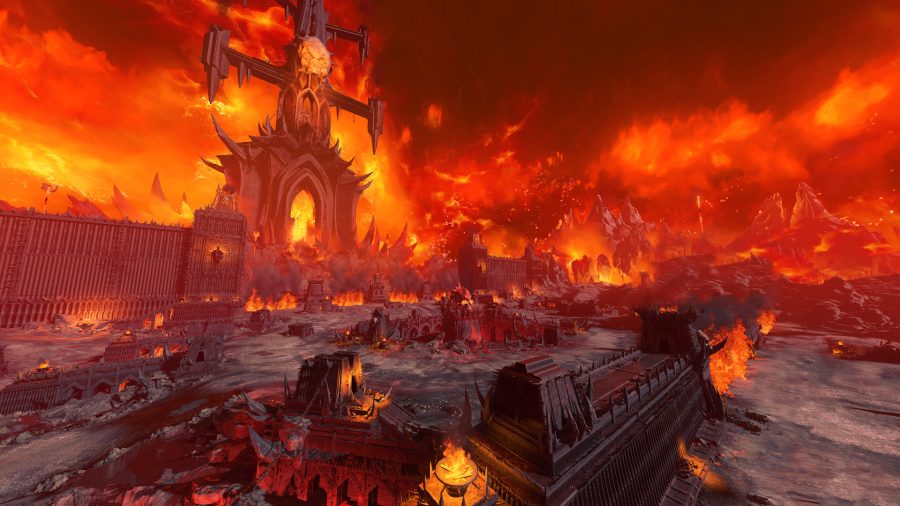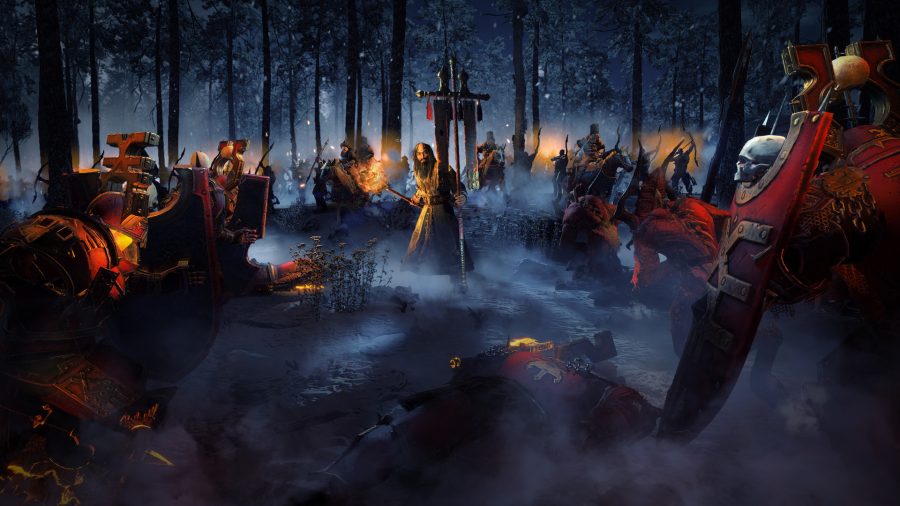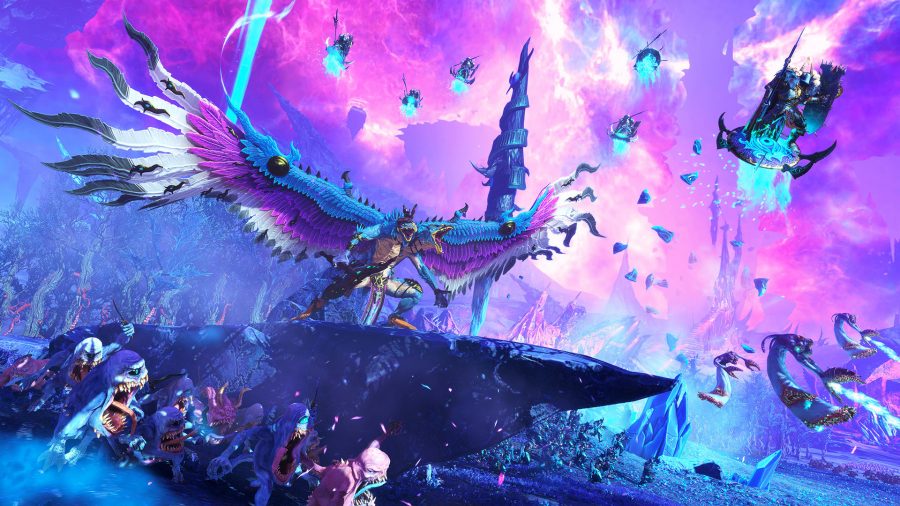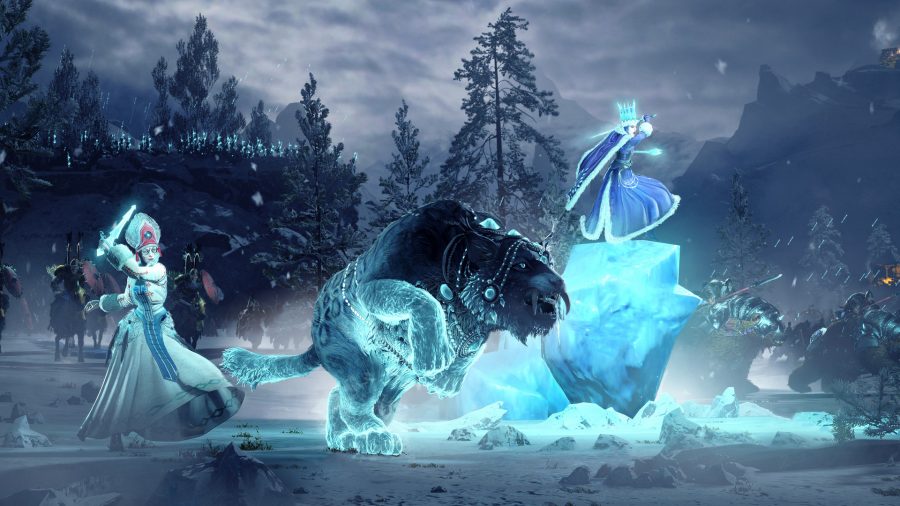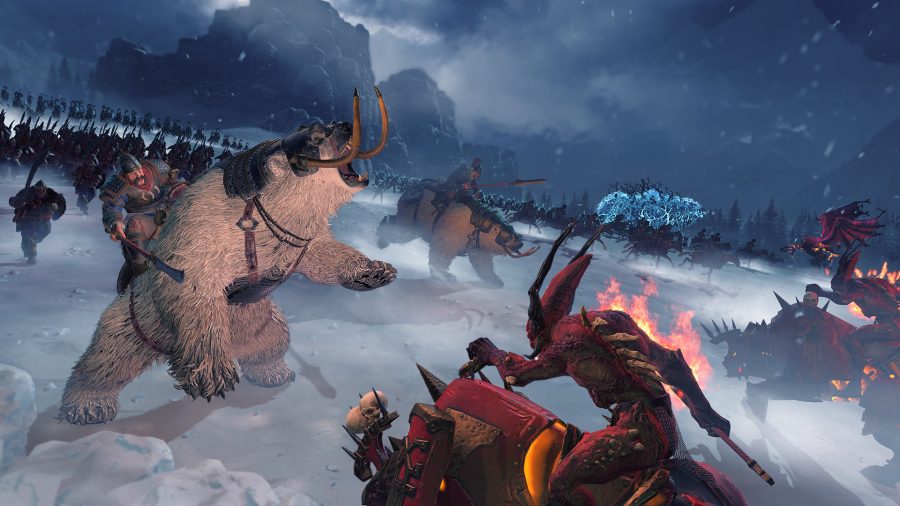With less than a month to go until release, Total War developer Creative Assembly has flung aside the curtain on Total War: Warhammer III – which you can pre-order here, coincidentally . That doesn’t mean we know everything about the strategy game now, but we’ve glimpsed enough to understand how much more there is to see. The curtain stretches for miles.
I recently got to play 50 turns of the single-player campaign as both the Daemons of Chaos and Grand Cathay’s Miao Ying. Mid-way through my session I’d thrown away most of my prepared questions and vibed my interview with game director Ian Roxburgh and principal writer Andy Hall, who had a lot of fun with the fact that I know enough about Warhammer to make certain assumptions which he, apparently, plans to upend.
You can read my hands-on impressions here and catch up on the headlines regarding Be’lakor, customisable Daemon Princes, the Great Maw, and eight-player co-op multiplayer at those links – like I said, big curtain – but first on the agenda is a new mechanic that’s core to the campaign: rifts.
Rifts will erupt periodically across Warhammer III’s campaign map – an event that acts as a similar inflection point to Warhammer II’s Vortex rituals – and having not appreciated the powerful hostile armies that those rituals plonked into the middle of my empire, I’m immediately worried.
PCGamesN: So, these rifts. How bad do they get in terms of spewing out Chaos stacks?
Ian Roxburgh: Well, one thing I’d say is that’s part of the mechanic that ties in very closely with the narrative. It’s a way of bringing that Chaos threat, which is at the centre of the story, into the player a bit more to create more interesting gameplay. If you don’t deal with those rifts – and you can get rid of them with a hero action or by using an army in a minor battle – then the amount of corruption over your lands increases each turn, and then they’ll ramp up to the point of spewing out Chaos armies that you have to deal with. They’ll cause all sorts of public order problems and rebellions and completely negate any growth.
Maybe the first time it happens, it will take you by surprise a bit. But once you know how it works, you’ll soon be able to deal with it. We give you all the tools you need to manage that process and stop it becoming a massive problem. But you can’t sit there and leave your homelands completely empty with all your armies scattered around, because if you’re not careful, that’s [when it] can become a problem.
So it brings out these decisions while you’re building your empire. In the previous two Warhammer games I never really cared too much about my public order, because it was never much of an issue. Whereas now you need to think about it a lot more when the rifts come in, because if you’re not able to deal with them straight away, that negative public order from the corruption is really going to cause problems. That’s why each faction has its own ways of dealing with the increasing corruption – one of the Wu-Xing compass points you can choose as Cathay is a massive anti-corruption mechanism; Kislev has various buildings that can do it, as well as the Atamans feature.
So we give the player tools to deal with it – you might want to change your commandments to include a corruption-reducing one, when previously you may not have felt the need and just kept one commandment the whole time. You also get a warning through a story panel five turns before, so [there are] plenty of tools. And that’s a response to the feedback we got from the Vortex in Warhammer II: sometimes it felt a bit contrived that you can’t control it, and there’s going to be a few stacks coming in and attacking you. Here, you can manage your way out of it, you can strategise your way out of it, so they’re a very fundamental part of the gameplay.
It’s also a key part of bringing the narrative in. It’s also our mechanism for allowing the player to get in and out of the Chaos realms, and to deal with the other central part of the story without you having to spend turns and turns moving around the map. Or, when the rifts open up, you can also decide not to enter the Realm of Chaos and just use them to teleport around the world and go and beat up the ogres. It brings the whole world closer to you, because this map is twice as big as the Warhammer II map, right? It’s massive, so the rifts serve both the gameplay and the narrative really well.
PCGN: Were there any other reflections that you guys had on the Vortex campaign that’s influenced the campaign here?
Andy Hall: Having a final battle in which we’ll actually be able to fight the villain of the piece, so to speak. In the Vortex campaign, it turns out that the Horned Rat himself was behind all the machinations, so he kind of appears in the skybox and looks very threatening. But this time, obviously, Be’lakor is the villain, and I don’t think it’s a spoiler to say that you will confront him in the final battle and actually have to fight him. This is, effectively, our first final boss battle in Total War. I think that’ll be very satisfying for the player.
IR: Another bit of feedback we got was that the final battle [in the Vortex campaign] was maybe a bit too easy. So we were like, ‘ok, let’s keep an eye on that – let’s make it challenging, but do-able.’ This is the way we’ve treated the whole trilogy and the DLC; it’s always a constant process of listening to the feedback and looking to evolve. And that’s across the board: that’s balancing, that’s the UI, the big central features, and the other features people might like. The rework of sieges is a good example of that, it was very much driven by fan sentiment, as is the return of minor settlement battles. Warhammer III is really the culmination of all that feedback.
But then we’re going to throw some curveballs and put in things fans would never have expected, like eight-player simultaneous campaign multiplayer. No one would dream of that happening. It’s so much fun, we’ve had a blast developing that. We’ve even created mini-campaigns, so that you can start and finish an eight-player multiplayer campaign in one evening with friends and get a more social, digestible experience rather than a six-month epic where you play the whole campaign. But of course, people who want to do that can.
Another example is the Daemon Prince. We’ve never done something that’s as customisable as a Legendary Lord before, and people are finding it really exciting that they can tailor their lord the way they want. And not just that, but the [Daemons of Chaos] army now has effectively four whole army rosters to pick from, and you can create all manner of combinations that can combine with your Daemon Prince. It’s like a never-ending toy box for the player to have fun with and experiment with, and we’ve never been able to do that in a Total War game before.
We’re really, really pleased with the way it’s come out, and the feedback we’ve been getting so far is overwhelmingly positive. And you know, there’s a lot more to come post-release as well.
PCGN: The Plains of Zharr are looking roomy and ripe for the Chaos Dwarfs. But of course I know better than to try to draw you on that…
AH: The Chaos what?
IR: Chaos Dwarfs… do they even exist?
PCGN: Like the Skaven, just a rumour. Turning to Be’lakor, it’s cool to see him confirmed as the final boss after so much community speculation. Will he be playable at all? He seems an obvious fit for a Chaos Undivided Legendary Lord, at some point.
AH: Yeah, I mean, I’m sure we’ll get to that place. But we knew early on that we wanted him as our villain, because that’s his role in Warhammer, whether from Mordheim or even the End Times. He’s ideal for that role because the Chaos Gods hate him, and the goodies certainly aren’t friends with him either, so he can do stuff that will affect everyone and everyone’s gonna try and stop him. He’s a classic villain who’s full of plots and machinations, but he’s also a big, hulking demon creature, so he can fulfil that role of having a bit of muscle but being very intelligent with it as well. And of course, we know he’s a fan favourite.
We’ve got a really good voice actor [for him] in Richard Armitage, and – slight spoiler – you may or may not be able to play him at some point during Warhammer III. We’ll let players discover that for themselves.
IR: I’m sure, post release, that we’ll be looking at maybe doing other things with him. But, on the speculation, people have wondered about him being a Daemons of Chaos Lord and everything, but they didn’t know that we’ve created that with the customisable Daemon Prince. We can’t break the established lore by making a Karl Franz or a Be’lakor customisable, but the Daemon Prince as a concept can look like a million different things, and their army roster allows you [that same customisability]. The Daemon Prince is also fundamentally built into the prologue, where the story tells you about how that particular Daemon Prince came about.
PCGN: Yes, is he Yuri Kovalenko?
AH: He’s Yuri, but there’s more than one Yuri in Kislev.
IR: Yeah, it’s not a currently known Yuri in the canon, so don’t draw any parallels there. But his name happens to be Yuri.
PCGN: But he is the Yuri referred to in Katarin’s letter in the first Warhammer III trailer?
IR: Yeah.
AH: That’s a very fanboy point, well spotted.
IR: It’s been really fun, the way it knits together – how that prologue tells the beginning of this story, and then that feeds into the main game and it all comes together in how the rifts work and your reasons for entering the Realms of Chaos. And the movies are absolutely incredible in this game, they’ve really upped the ante. The game and the mechanics themselves tell the story in their own right, but if you do watch the movies, it just immerses you in that world even more than simply graphics and mechanics and game features. We’re really proud of knitting all those things together.
![]() Total War: Warhammer III Total War: Warhammer III $59.99 $47.39 Pre-order Network N earns affiliate commission from qualifying sales.
Total War: Warhammer III Total War: Warhammer III $59.99 $47.39 Pre-order Network N earns affiliate commission from qualifying sales.
PCGN: The advisor is looking great in the movies, and we learn a lot about his own motives at last. Just to confirm, he’s definitely the Light Wizard who appeared in the very first Total Warhammer trailer and was snared by the book, isn’t he?
AH: He is, yeah. He looks a bit younger than he does in Warhammer I, doesn’t he?
PCGN: Yes, he does. He’s grown some hair back.
AH: That’s very interesting, isn’t it? That’s not a mistake. Let’s just say that.
IR: That’s just teasing!
PCGN: I’m not sure how to follow up on that! With everything we’ve seen from this preview event I have a clear idea of the premise of the story, but it seems there are way more twists and turns during the full game and in each faction’s campaign?
AH: Yeah, yeah. I mean… yeah [laughs]. The further you get, the more realms you complete, the more Be’lakor’s actual plan is revealed.
PCGN: That’s interesting. As you said, he’s hated by the Dark Gods and has always wanted to overthrow them, so it’s easy to assume if you know a little about the lore, that his plan is just to eat Ursun or something and become super powerful.
AH: That’s right, yeah. You’d just assume that’s what he’s up to, wouldn’t you?
PCGN: Finally, are you ready to say anything more about Immortal Empires?
IR: It’s definitely coming, and it’ll be everything we promised – all three games combined. We’re not going into detail about the shape it’ll take yet, but rest assured it’s still the ultimate culmination of the vision behind the trilogy. I don’t think the map will be much bigger, because the map in Warhammer III is twice as big as before, and bigger than Mortal Empires.
PCGN: That’s what I was wondering about, because you understandably needed to cut chunks off Warhammer I and II’s campaign maps to combine them. With Warhammer III’s map being so huge, and so skewed around the north pole, presumably those contortions are even more severe?
IR: Actually, I think the contortions are slightly less severe. We adjust the map in order to fit in that bigger scope, so you won’t find that it’s a direct copy and paste of the landmasses in Warhammer I and then II, because that wouldn’t work. All of those areas will be included, we’ve just redesigned the map to be able to accommodate them all, and maybe even a few more.
It’s very much a project in its own right, which is why the whole plan around the trilogy has had to bear this in mind – it’s effectively an entire game that’s going out for free. It’s a big undertaking and a lot of work, but it was always the promise and the desire to say, ‘ok, if fans have been on this journey with us for three whole games, we want to give them that massive thing at the end.’ We knew from the beginning that that would be the experience everyone would want, and it’s the experience we would want as fans as well. We want the whole Warhammer Fantasy world in one map, right? So yeah, it’s gonna be special.
The Total War: Warhammer 3 release date is set for February 17, 2022, and you can pre-order it here.
![]() Total War: Warhammer III Total War: Warhammer III $59.99 $47.39 Pre-order Network N earns affiliate commission from qualifying sales.
Total War: Warhammer III Total War: Warhammer III $59.99 $47.39 Pre-order Network N earns affiliate commission from qualifying sales.
